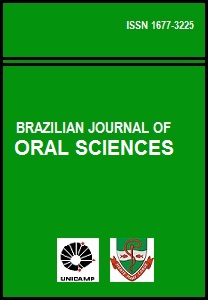Abstract
Estimating enamel thickness and planning the resultant optimal morphology of premolars are substantial steps before interproximal stripping. Aim: To analyze proximal enamel thickness and crown measurements in maxillary premolars. Methods: The mesiodistal, buccolingual and cervico-occlusal measurements of 40 human maxillary first premolars (20 right, 20 left) were registered with a digital caliper. The teeth were embedded in acrylic resin and sectioned mesiodistally at the level of the contact areas to obtain 1 mm-thick central sections. Enamel thickness on the proximal surfaces was measured using a perfilometer. Measurements were compared by the Student’s t-test (α = 0.05). Results: The mean enamel thickness on the mesial surface was 1.22 mm for the right (± 0.17) and left (± 0.18) sides. On the distal surface, the corresponding values were 1.28 mm (± 0.19) on the right side and 1.39 mm (± 0.17) on the left side. Mean values, in millimeters, for the mesiodistal, buccolingual and cervico-occlusal measurements on both sides ranged from 7.03 (± 0.43) to 7.07 (± 0.48), 9.59 (± 0.48) to 9.65 (± 0.58) and 8.65 (± 0.66) to 8.85 (± 0.65), respectively. There were no significant differences between right and left teeth. However, enamel thickness was significantly greater (p<0.05) on the distal surface. Conclusions: In maxillary first premolars, considering the greater thickness of distal enamel, interproximal stripping during orthodontic treatment may be more pronounced on this surface. The greatest mean value was observed for the buccolingual crown measurement, followed by the cervicoocclusal and mesiodistal dimensions.The Brazilian Journal of Oral Sciences uses the Creative Commons license (CC), thus preserving the integrity of the articles in an open access environment.
Downloads
Download data is not yet available.

